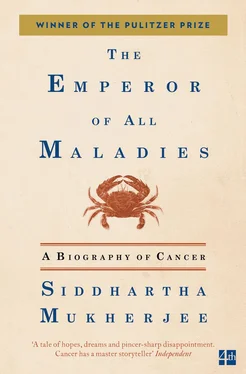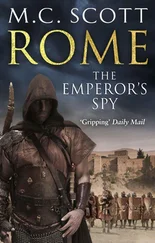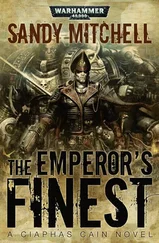1 ...7 8 9 11 12 13 ...17 Farber’s Gauntlet
Throughout the centuries 81the sufferer from this disease has been the subject of almost every conceivable form of experimentation. The fields and forests, the apothecary shop and the temple, have been ransacked for some successful means of relief from this intractable malady. Hardly any animal has escaped making its contribution, in hair or hide, tooth or toenail, thymus or thyroid, liver or spleen, in the vain search by man for a means of relief.
—William Bainbridge
The search for a way to eradicate this scourge 82. . . is left to incidental dabbling and uncoordinated research.
—The Washington Post, 1946
Seven miles south of the Longwood hospitals in Boston, the town of Dorchester is a typical sprawling New England suburb, a triangle wedged between the sooty industrial settlements to the west and the gray-green bays of the Atlantic to its east. In the late 1940s, waves of Jewish and Irish immigrants—shipbuilders, iron casters, railway engineers, fishermen, and factory workers—settled in Dorchester, occupying rows of brick-and-clapboard houses that snaked their way up Blue Hill Avenue. Dorchester reinvented itself as the quintessential suburban family town, with parks and playgrounds along the river, a golf course, a church, and a synagogue. On Sunday afternoons, families converged at Franklin Park to walk through its leafy pathways or to watch ostriches, polar bears, and tigers at its zoo.
On August 16, 1947, in a house across from the zoo, the child of a ship worker in the Boston yards fell mysteriously ill with a low-grade fever that waxed and waned over two weeks without pattern, followed by increasing lethargy and pallor. Robert Sandler 83was two years old. His twin, Elliott, was an active, cherubic toddler in perfect health.
Ten days after his first fever, Robert’s condition worsened significantly. His temperature climbed higher. His complexion turned from rosy to a spectral milky white. He was brought to Children’s Hospital in Boston. His spleen, a fist-size organ that stores and makes blood (usually barely palpable underneath the rib cage), was visibly enlarged, heaving down like an overfilled bag. A drop of blood under Farber’s 84microscope revealed the identity of his illness; thousands of immature lymphoid leukemic blasts were dividing in a frenzy, their chromosomes condensing and uncondensing, like tiny clenched and unclenched fists.
Sandler arrived at Children’s Hospital just a few weeks after Farber had received his first package from Lederle. On September 6, 1947, Farber began to inject Sandler with pteroylaspartic acid or PAA, the first of Lederle’s antifolates. (Consent to run a clinical trial for a drug—even a toxic drug—was not typically required. Parents were occasionally cursorily informed about the trial; children were almost never informed or consulted. The Nuremberg code for human experimentation, requiring explicit voluntary consent from patients, was drafted on August 9, 1947, less than a month before the PAA trial. It is doubtful that Farber in Boston had even heard of any such required consent code.)
PAA had little effect. Over the next month Sandler turned increasingly lethargic. He developed a limp, the result of leukemia pressing down on his spinal cord. Joint aches appeared, and violent, migrating pains. Then the leukemia burst through one of the bones in his thigh, causing a fracture and unleashing a blindingly intense, indescribable pain. By December, the case seemed hopeless. The tip of Sandler’s spleen, more dense than ever with leukemia cells, dropped down to his pelvis. He was withdrawn, listless, swollen, and pale, on the verge of death.
On December 28, however, Farber received a new version of antifolate from Subbarao and Kiltie, aminopterin, a chemical with a small change from the structure of PAA. Farber snatched the drug as soon as it arrived and began to inject the boy with it, hoping, at best, for a minor reprieve in his cancer.
The response was marked. The white cell count, which had been climbing astronomically—ten thousand in September, twenty thousand in November, and nearly seventy thousand in December—suddenly stopped rising and hovered at a plateau. Then, even more remarkably, the count actually started to drop, the leukemic blasts gradually flickering out in the blood and then all but disappearing. By New Year’s Eve, the count had dropped to nearly one-sixth of its peak value, bottoming out at a nearly normal level. The cancer hadn’t vanished—under the microscope, there were still malignant white cells—but it had temporarily abated, frozen into a hematologic stalemate in the frozen Boston winter.
On January 13, 1948, Sandler returned to the clinic, walking on his own for the first time in two months. His spleen and liver had shrunk so dramatically that his clothes, Farber noted, had become “loose around the abdomen.” His bleeding had stopped. His appetite turned ravenous, as if he were trying to catch up on six months of lost meals. By February, Farber noted, the child’s alertness, nutrition, and activity were equal to his twin’s. For a brief month or so, Robert Sandler and Elliott Sandler seemed identical again.

Sandler’s remission—unprecedented in the history of leukemia—set off a flurry of activity for Farber. By the early winter of 1948, more children were at his clinic: a three-year-old boy brought with a sore throat, a two-and-a-half-year-old girl with lumps in her head and neck, all eventually diagnosed with childhood ALL. Deluged with antifolates from Yella and with patients who desperately needed them, Farber recruited additional doctors to help him: a hematologist named Louis Diamond, and a group of assistants, James Wolff, Robert Mercer, and Robert Sylvester.
Farber had infuriated the authorities at Children’s Hospital with his first clinical trial. With this, the second, he pushed them over the edge. The hospital staff voted 85to take all the pediatric interns off the leukemia chemotherapy unit (the atmosphere in the leukemia wards, it was felt, was far too desperate and experimental and thus not conducive to medical education)—in essence, leaving Farber and his assistants to perform all the patient care themselves. Children with cancer, as one surgeon noted, were typically “tucked in the farthest recesses 86of the hospital wards.” They were on their deathbeds anyway, the pediatricians argued; wouldn’t it be kinder and gentler, some insisted, to just “let them die in peace” 87? When one clinician suggested that Farber’s novel “chemicals” be reserved only as a last resort for leukemic children, Farber, recalling his prior life as a pathologist, shot back, “By that time, the only chemical 88that you will need will be embalming fluid.”
Farber outfitted a back room of a ward near the bathrooms into a makeshift clinic. His small staff was housed 89in various unused spaces in the Department of Pathology—in back rooms, stairwell shafts, and empty offices. Institutional support was minimal. Farber’s assistants sharpened their own 90bone marrow needles, a practice as antiquated as a surgeon whetting his knives on a wheel. Farber’s staff tracked the disease in patients with meticulous attention to detail: every blood count, every transfusion, every fever, was to be recorded. If leukemia was going to be beaten, Farber wanted every minute of that battle recorded for posterity—even if no one else was willing to watch it happen.

That winter of 1948, a severe and dismal chill descended on Boston. Snowstorms broke out, bringing Farber’s clinic to a standstill. The narrow asphalt road out to Longwood Avenue was piled with heaps of muddy sleet, and the basement tunnels, poorly heated even in the fall, were now freezing. Daily injections of antifolates became impossible, and Farber’s team backed down to three times a week. In February, when the storms abated, the daily injections started again.
Читать дальше













